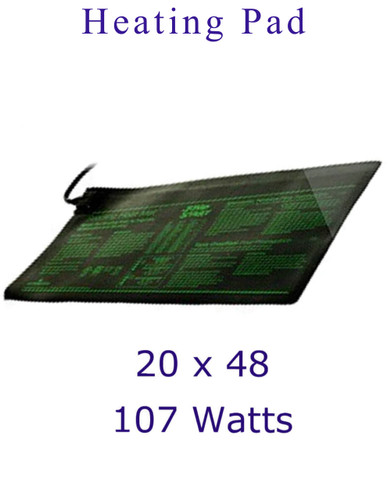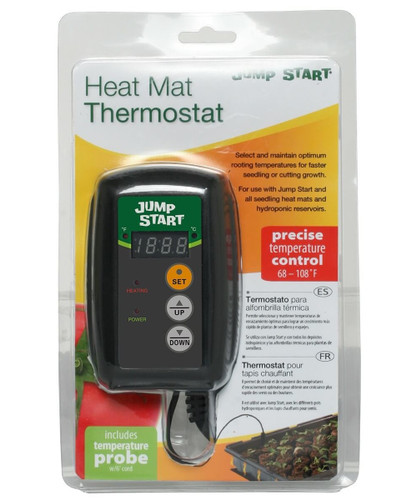Description
Take the Chill off your Kombucha and favorite brew and order today. Be ready for winter.
measures 11 1/2 X 11 1/2. durable hard plastic 110 volts AC runs constant 25 watts . 3 year unlimited warranty. availble with thermostatic control (see below)
Our heating panels help keep things constant and more reliable. Cooler temperatures take longer to ferment and due to the slower build-up of acetic acids the cooler temperatures are more prone to contamination by mold and pathogens. Regardless if one prefers cool brewing or a faster warmer ferment, or the Continuous Brewing Method, the pH should be at 3.0 or lower for kombucha tea as well as other lactic and acetic acids ferments.
The heating panel is a perfect size for one -four one gallon fermentation jars, up to 5 1/2 gallon jars, 3 -2 gallon glass jars with a little hangover. Works for our Continuous Brew Containers, and carboys as well. Raises temperature of a full 5 gallon carboy by about 10-15 degrees (above ambient temperature).
For kombucha brewing, Time and Temperature are 2 of the 4 most critical variables, others being type of tea and sugar. Most researchers seem to favor a 6-8 day ferment at 80 F. ( 22 C) where a balance between taste and health are believed arrived at. Nowadays that appears to be a little longer, a little sourer ferment at about 10 days. In my opinion, it really matters most to the individual. The kombucha will ferment visibly well in a range from the mid 60’s to the high 80’s. One German researcher thought that a 90 degree temperature to be more optimal. The Home Brewer should keep in mind that at temperatures above 103 F enzymes begin dying off, in the low 60’s the kombucha favorite yeasts go dormant and other yeasts begin to flourish. Therefore, one should endeavor to maintain a temperature in the 70-80’s range. Our booklet goes into more detail as does several articles in our online library. Other Uses Kefir and yogurt fermenting, drying herbs or fruits, or germinating seeds. Sprouting Wheat Grass, also a neat and clean foot warmer, and a neat lizard playground
Temperatures that are too high kill enzymes, temperatures that are too low and too slow drying may promote mold. Different ferments have more desired temperatures; 65 to 75 degress range during primary fermentation for beer, while 70 and 75 degrees as specified in many wine kits. For Kefir brewing, the best fermentation temperature is between 84 F (22°C and 30°C). Which is also ideal for kombucha. Researchers have found nearly 30 different bacteria and 25 different yeasts in Kefir cultures. Every bacteria and culture has specific temperature requirements. This is why a constant low temperature can't be compensated with a longer fermentation time, or a constant high temperature with a shorter fermentation time. Brewing needs some balance, like hatching an egg. When drying herbs, the right temperature is also important. With too low temperatures and maybe too high humidity, mold develops easily. Too high temperatures kill the life force, the enzymes of the food.
Our heating Panels (Blue hard plastic 111.5 x 11.5) are set at 25 watts constant which are expoected to raise the ferment 10-20 degrees F over ambient temperatures. Our Heating mats ( 10 x 20 soft plastic) are set at 17 watts constant and are expected to raise the temperature about 10 degrees above ambient. If it's too warm during the day, just get a lamp timer, and have it turn on only at night. Heating mats or panels vs. heat belt. heat belt instructions state not to attache it to a glass carboy and even some of the glass carboys say not to apply heat, as it may cause the glass to crack. Heat belts would be suitable for the FDA approved heat resistent plastic buckets (HPDE 1 or 2) which are rated up to 190F.
For optimum temperature control use with our Heat Mat Thermostat Without the thermostat, the temperature is expected to be about 10-20 degrees warmer than the surrounding environment and the unit is on constantly. We recommend you do a test run first. Use the same size container as you would for your ferment but filled with water. Allow sitting 12-24 hours and then testing your sample. If it’s too warm try a taller thinner container and/or greater volume. Another method is to add a few coins between the container and the heating pad. Do not use towels or block off the airflow as this may create a heat sink or potential fire hazard. Most pro-biotic ferments are anaerobic (with oxygen) and a closed or enclosed area may starve your ferment. Sprouting seeds, on the other hand go nicely in closets - but there is a tendency for mold to quickly develop. The northern portion of your home is usually a few degrees cooler, and the southern portion warmer and sunnier. The thermostat makes life a little more pleasurable and actually saves on your energy bill.
Made special for the Happy Herbalist to our specifications for kombucha brewing. Works for other ferments as well.

Features
Water resistant stainless steel temperature probe
- Digital temperature controller for heat mats
- Provides constant optimum temperatures for specific crops
- Controls temperature in colder or warmer environments
- LED mode indicator lights; 3-prong grounded plug
- Compatible with all heat mats
- Controllable range from 68 to 108 degrees Fahrenheit
- Celsius or Fahrenheit read-out (press Up or Down button to change)
- Max current: 8.3 amps / 1000 watts
Temperature Control Range 68 - 108 F (20-37 C). Can Control multiple units up to 500 watts
Additional Details
- SKU:
- Heat25














